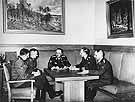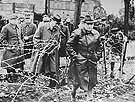
|
|
|

|

|

|

|
|
Click on an image to see a larger, more detailed picture.
|
|
|
|
|
| 1939: The War Against The Jews |

|
pg. 181 |

|
|
|
|
| |
 Senior SS officers meet at Gestapo headquarters in Munich in November 1939. Pictured from left to right are Gestapo chief Heinrich Müller; Franz Josef Huber, leader of the Gestapo in Vienna; SS Chief Heinrich Himmler; Reinhard Heydrich, head of the Security Service (SD); and Arthur Nebe, chief of Kripo (criminal police). They may have discussed the role of the German police forces in the newly acquired Polish territories.
Senior SS officers meet at Gestapo headquarters in Munich in November 1939. Pictured from left to right are Gestapo chief Heinrich Müller; Franz Josef Huber, leader of the Gestapo in Vienna; SS Chief Heinrich Himmler; Reinhard Heydrich, head of the Security Service (SD); and Arthur Nebe, chief of Kripo (criminal police). They may have discussed the role of the German police forces in the newly acquired Polish territories.
Photo: United States Holocaust Memorial Museum Photo Archive
|
 Edouard Daladier, premier of France, inspects the Maginot Line in November 1939. The Maginot Line, which consisted of a series of fortresses built along the Franco-German border designed to halt a cross-Rhine invasion, was the centerpiece of French defense plans. In the end, the fortress complex could not stop the German invasion in the spring of 1940. The Germans simply went around it, invading France through Belgium.
Edouard Daladier, premier of France, inspects the Maginot Line in November 1939. The Maginot Line, which consisted of a series of fortresses built along the Franco-German border designed to halt a cross-Rhine invasion, was the centerpiece of French defense plans. In the end, the fortress complex could not stop the German invasion in the spring of 1940. The Germans simply went around it, invading France through Belgium.
Photo: United States Holocaust Memorial Museum Photo Archive
|
 Ghettoization
Ghettoization
"What has today brought us?" wrote Chaim Kaplan, a Jew, on November 5, 1939. "A ghetto in Jewish Warsaw!" First used in Venice, Italy, in 1516, the word "ghetto" originally referred to a city area occupied only by Jews who had segregated there. The Germans made that concept much more deadly. The ghettos they established soon after their 1939 invasion of Poland initially were intended to be transitional concentration areas to hold Jews, all of whom were to be excluded from Aryan resettlement of desirable, formerly Jewish areas. Later, the only possible Jewish "escape" from the ghettos was via deportation to extermination/slave-labor camps built by the Nazis in Poland. The Nazis established their first ghetto on October 8, 1939. It stood at Piotrków Trybunalski in the Lódz district of Occupied Poland. A year later Kaplan was among about 500,000 Jews in Warsaw, Poland, who struggled to survive in constantly deteriorating ghetto conditions. Afflicted by hunger, squalor, overcrowding, sickness, and despair, the Warsaw Ghetto and others like it--in cities such as Lódz and Lublin (Poland), Lvov and Minsk (Soviet Union), Kovno and Vilna (Lithuania), and Riga (Latvia)--became places of immense suffering and death. During 1942 and 1943, the Nazis "liquidated" the ghettos by deporting and murdering their inhabitants. Kaplan was gassed at the Treblinka, Poland, extermination camp.
Photo: Not for release without permission of the Life Picture Service, United States Holocaust Memorial Museum Photo Archive
|
|

|

|

|

|
 November 30, 1939-March 13, 1940: The USSR invades Finland and carries out the Winter War.
November 30, 1939-March 13, 1940: The USSR invades Finland and carries out the Winter War.
|
 December 1939: German Field Marshal Johannes Blaskowitz, commander-in-chief of the German Army Group East, reports that many Jewish children in transport trains are arriving at their destinations frozen to death.
December 1939: German Field Marshal Johannes Blaskowitz, commander-in-chief of the German Army Group East, reports that many Jewish children in transport trains are arriving at their destinations frozen to death.
|
 December 1939: The Lipowa camp at Lipowa Street in Lublin, Poland, is established. It is initially an assembly point for Polish-Jewish POWs, and it will later be a Jewish work camp.
December 1939: The Lipowa camp at Lipowa Street in Lublin, Poland, is established. It is initially an assembly point for Polish-Jewish POWs, and it will later be a Jewish work camp.
|
 December 1939: Lódz (Poland) Ghetto administrator Friedrich Übelhör notes that ghettoization of Jews is only temporary. The final goal is to clean Jews out of Lódz, to "utterly destroy this bubonic plague."
December 1939: Lódz (Poland) Ghetto administrator Friedrich Übelhör notes that ghettoization of Jews is only temporary. The final goal is to clean Jews out of Lódz, to "utterly destroy this bubonic plague."
|
 December 1, 1939: 1350 Jews are murdered by German troops at Chelm, Poland.
December 1, 1939: 1350 Jews are murdered by German troops at Chelm, Poland.
|
 December 1-9, 1939: The forced march of 1800 Jewish men from Chelm and Hrubieszow, Poland, to the Soviet border results in the deaths of all but 200.
December 1-9, 1939: The forced march of 1800 Jewish men from Chelm and Hrubieszow, Poland, to the Soviet border results in the deaths of all but 200.
|
|
|
|
|
| 1939: The War Against The Jews |

|
pg. 181 |

|
|
The Holocaust Chronicle
© 2009 Publications International, Ltd.
|
|
